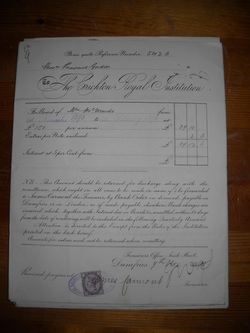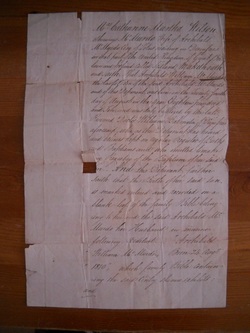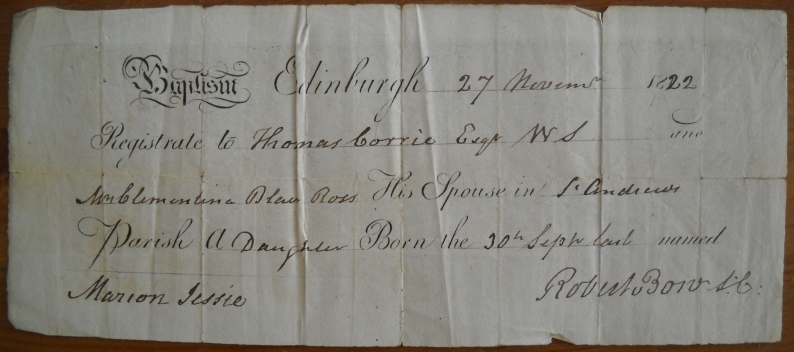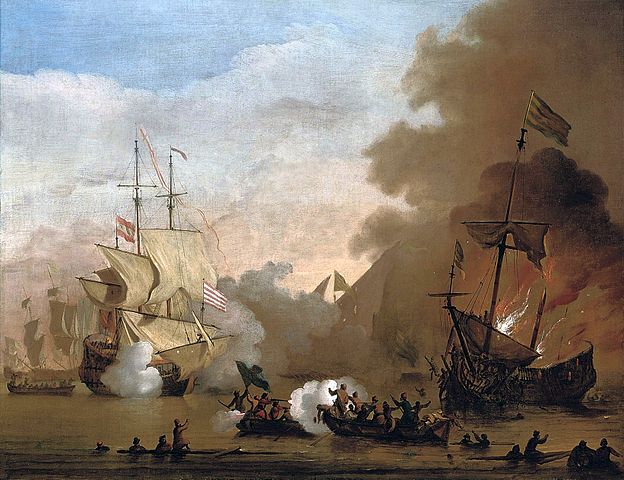 1895 receipt from Crichton Royal 1895 receipt from Crichton Royal It's International Archives Day, so we thought we'd share a few items from our own archives that together offer some useful family history research. In this first selection, what first caught our attention was a series of receipts from Crichton Royal Institution in Dumfries for the care of Mrs McMURDO. The Crichton was a pioneer in mental health care, and in its day it was one of the most renowned psychiatric hospitals in the world. It was one of the first institutions to introduce art therapy, and the hospital's records - currently being preserved and catalogued by a dedicated team of researchers and volunteers - include patient artworks as well as more conventional medical and patient records. You can read all about the project here. (Opens in a new window) The next document is an 1822 baptism certificate from Edinburgh for Marion Jessie CORRIE, daughter of Thomas CORRIE WS (Writer to the Signet) and his wife Clementina Blair ROSS. This is a printed slip with the details completed by hand (by one Robert BONE). Such slips were regularly issued by many parishes, although being ephemeral, relatively few of them survive.  1829 affidavit of Catherine Martha McMurdo 1829 affidavit of Catherine Martha McMurdo The third document is a very fragile 1829 affidavit from Catherine Martha WILSON or MCMURDO, affirming that her son, Archibald William McMURDO, had been born on 24 August 1810 and had been baptised by Rev. Dr. William BABINGTON of Dumfries, “who, as the Deponent has heard and believes, kept no regular Register of Births and Baptisms”. Before the introduction of statutory registration of births, deaths and marriages in 1855, there are significant gaps in records of births and baptisms in Scotland, particularly in towns. In support of her affidavit, Archibald’s mother exhibited the family bible to John MACGEORGE, Justice of the Peace in Dumfries. A little research showed that William BABINGTON was a minister of the Episcopalian Church in Dumfries, which would explain why could not find the baptism of Archibald in the Church of Scotland records. The collection also contains a number of receipts, including one from 1888 for £2 19s 2d from Brandon’s Limited of Oxford Street in London, a self-described “fashionable millinery establishment”. Another receipt was for Poor Rates for the parish of Troqueer levied in 1897 on a Mrs M J MCMURDO. This was clearly a well-to-do family. Given the fairly uncommon family name – McMURDO – we wondered if there was any connection to Admiral Archibald McMURDO, after whom McMurdo Sound in Antarctica was named. A little bit of digging confirmed our suspicions. Admiral Archibald William McMURDO’s death record [1] shows that he had been married to Marion Jessie CORRIE, and that his parents were Archibald McMURDO, an army officer and Catherine McMurdo WILSON. Archibald McMurdo senior died in October 1829 in Dumfries, just a few weeks after Catherine Martha Wilson/McMurdo’s affidavit about her son’s birth. One possibility is that this affidavit may have been drawn up to allow Admiral McMurdo to inherit his father’s estate of Cargenholme in Troqueer. We looked online and found quite a number of family trees with Archibald MCMURDO, and almost all of them claim he was born in 1812, as indeed does his Wikipedia entry. Some of the trees also give the wrong set of parents (John James McMURDO and Emily FLOWER: John James McMURDO died in Edinburgh in 1867, and his death was officially registered by Admiral Archibald, who was in fact his brother, not his son). Taken together, these documents offer several important lessons for family historians and genealogists:
Old Scottish will always properly cite sources so that you can follow our research. Why not get in touch to see if we can help you discover your own Scottish roots? [1] Deaths. Scotland. Troqueer, Kirkcudbrightshire. 882. 11 December 1875. Archibald William McMURDO. NRS Data 882/0 0143.
0 Comments
We're now half way through the four years of centenaries of the First World War. The scale of the war is in many ways incomprehensible. Every village was affected - every village has its own war memorial. Whittingehame in East Lothian was no exception. Whittingehame's memorial was formally unveiled in 1920 by Arthur Balfour, former Prime Minister. Balfour had himself played a prominent role in the First World War, succeeding Winston Churchill as First Lord of the Admiralty on 25 May 1915, then becoming Foreign Secretary on 10 December 1916, a post he held until after the war. Balfour had been born in Whittingehame House, the son of the local MP, so it perhaps was no surprise that he agreed to unveil the war memorial in the parish of his birth. Recently, though, while looking through the records of Whittingehame Kirk Session, we came across war-time copies of the parish magazine. In the January 1915 issue, the parish minister gives a Roll of Honour: Roll of Honour for Whittingehame Parish It's worth bearing in mind that in 1911, there were only 92 men aged 18 to 40 in the whole parish. This would seem to suggest that around one-third of the adult male population had signed up a full year before conscription was introduced by the Military Service Act 1916. A year later, the parish magazine again contained a Roll of Honour Roll of Honour for Whittingehame Parish, January 1916 The number of men in service had increased a little, and five men - Matthew Symington, David Stoddart, George Burgess, James Gray, Matthew Keiller and William Johnston - had been killed and another six injured. The toll continues to rise in the January 1917 issue of the parish magazine: [List of the dead] By this stage, going by the 1911 population figures, roughly half of the adult males in the parish were in the armed forces. The final list is then produced in the 1918 issue of the Parish Magazine I print a Roll of Honour for the Congregation and Parish, which is as complete and up-to-date as I can manage to make it from any information that has been given me. I look forward to making express use of it especially in our meeting for prayer on the first Sunday of 1918, as the King has suggested. First, in a special Roll by themselves, I inscribe those who have died for home and country and for the great cause of righteousness and humanity involved in this War. They were seven in number a year ago; now they are twelve. We shall not see them again in this world, but we cherish their memory; it is a very sacred memory to us; for “greater love hath no man than this, that a man lay down his life for his friends.” There is no reason to suppose that Whittingehame was in any way exceptional in this regard. It just goes to show the enormity of World War I that roughly half the men of the village saw action, of whom about a quarter were killed.
Upcoming family history talks and events in Scotland, 4 - 10 June 2016
Note that there may be a small charge for some of these events, and some may be for members only. We will be publishing lists of upcoming talks and events regularly - if you are organising a talk or event relating to Scottish genealogy or history, please let us know and we will be happy to add your events to our list. Saturday, June 11 2016 WW1 Naval Records Ken Nisbet Venue: Scottish Genealogy Society Library, 15 Victoria Terrace, Edinburgh, EH1 2JL Monday, June 13 2016, 7.30 pm Henrietta Taylor Maggie Craig Venue: Huntly Library, The Square, Huntly, AB54 8BR Maggie will talk about a remarkable local woman from the Duff family, Henrietta Tayler, who served as a nurse in WW1 and who was an eminent scholar, publishing many books on a subject close to Maggie’s heart – the Jacobites and Jacobite rebellions of 1715 and 1745. Maggie has uncovered lots of interesting facts and stories about Henrietta and we are guaranteed an entertaining evening. Tuesday, June 14 2016, 10.15 - 11.45 am U3A Family History Group
Venue: Turriff Library, Grange Villa, The Square, Turriff, AB43 5AE For further details, please contact Turriff Library. Tuesday, June 14 2016, 7.30 pm Snippets of Researching my Family History Fife FHS members Venue: Volunteer House (Vonef Centre) in 69 Crossgate Cupar KY15 5AS Preceded by AGM Wednesday, June 15 2016, 2 pm The Picts Norman Atkinson OBE Venue: Monifieth Community Cabin, South Union Street, DD5 4JG Monifieth Local History Society Entry to talks followed by afternoon tea £4 Thursday, June 16 2016 Scotland and the Flemish People - Conference
Venue: University of St Andrews University of St Andrews 16-17 June 2016. http://flemish.wp.st-andrews.ac.uk/ Thursday, June 16 2016, 7.30 pm Open Night
Venue: Brora Community Centre A selection of the Society’s new archives on display
175 years ago today, a small army of enumerators set out all across Scotland - and the rest of the UK - tasked with carrying out a population census. It wasn't the first national UK census - that was organised in 1801, with others in 1811, 1821 and 1831 - but it was the first to attempt to record every man, woman and child in the country. As such, it is an enormously important record set for family historians.
The purpose of the census was to provide accurate and detailed statistical information about the country to enhance government decisions. This was arguably an approach that had been pioneered by Sir John Sinclair with the Statistical Account of Scotland - a monumental work that introduced the word statistics into the English language. It seems a fitting day, then, for us to have completed phase one of our Scottish surnames project. The idea is really quite simple - to investigate the frequency and geographical distribution of surnames in Scotland using, among others, census records. In our client and transcription work, we have built up a large database of surnames - over 8,500 so far - found in Scottish historical records. We want to know how common each of these surnames is in Scotland, and whether they are more common in any particular part of Scotland. Phase 1 of our project - which is now complete - entailed counting the number of times each surname is found in each of Scotland's 33 historic counties, and in the four largest cities (Aberdeen, Dundee, Edinburgh and Glasgow). Even the data-gathering part of this phase was a major task - we conducted over 300,000 database queries before we could even begin crunching the numbers. Having got the raw data, we then compared the number of instances of each surname [1] in each county with the total population of that county, giving the number of instances of each surname per 100,000 people in each county (the surname density). We then compared each county-frequency value with the equivalent figure for the whole of Scotland, to get an indication of relative surname density. [2] The higher the relative surname density, the more common the surname is in that county compared to Scotland as a whole. Our working hypothesis is that the higher the maximum relative surname density for a particular surname, the more likely that surname is to have a geographic origin in that area. We will be looking to test that hypothesis using a selection of surnames with known geographic origins. [3] A corollary to this initial hypothesis is that the lower the maximum relative surname density, the less likely the surname is to have a specific geographic origin. This appears to be borne out to some extent by the surnames with the lowest maximum relative surname density, shown in the table below
None of the top 9 surnames have a single origin, and the tenth - Frazer - may simply be a statistical artefact caused by the unusual spelling.
Several other interesting facts emerge from the initial results of this study.
[1] For the purposes of this study, we treated Mc- and Mac- surnames as identical.
[2] For example, there were 1580 Browns in Aberdeenshire in 1841. The total population of Aberdeenshire was 193,062. This means that the surname density for Brown in Aberdeenshire is Surname density (Brown in Aberdeen) = (1580 / 193,062) * 100,000 = 818.39
There were 28,617 Browns in the whole of Scotland in 1841, out of a total population of 2,589,636. So the surname density for Brown in Scotland is
Surname density (Brown in Scotland) = (28,617/2,589,636) * 100,000 = 1105.06
So the relative surname density for Brown in Aberdeen is
Relative surname density (Brown in Aberdeenshire) = Surname density (Brown in Aberdeenshire) / Surname density (Brown in Scotland) = 818.39 / 1105.06 = 0.7406
A relative surname density less than 1 indicates that the surname is less common in that county than in Scotland as a whole. Likewise a relative surname density greater than 1 indicates that the surname is more common in that county than in Scotland as a whole.
[2] A complication that arises here is that surnames based on specific place names may have first arisen elsewhere. Take for instance the surname Carstairs. This derives from the barony of Carstairs in Lanarkshire, but the surname is most commonly found in Fife. This can be explained by two 13th-century clergymen, Peter de Castiltarris (i.e. "of Carstairs") and John de Castiltarris, who were granted stipends in Dunkeld in 1231 and north-east Fife a little later in the 13th century. The progenitor of the surname presumably came from Lanarkshire, but the surname itself arose in and spread from Fife. Although perhaps at first glance counter-intuitive, this is in fact logical: it wouldn't make sense to refer to John of Carstairs in Carstairs itself, but away from Carstairs, "of Carstairs" would serve as a useful identifier.
Kirk Session records are a fantastic resource, not just for family history, but for Scottish history more generally. Along with the information more generally sought by genealogists - interrogations of unmarried mothers as to the paternity of their children (which we've written about here) - and the occasional panic about witchcraft and Sabbath breaking, they sometimes contain snippets of more general interest. The following appears in the West Calder Kirk Session minutes on 1 September 1678 [2]: A communication from the Privy Council being read for a voluntary contribution for the relief of Robert Williamson skipper in Montross [Montrose] and the rest of his company captives with the Turks in Algiers, the Session ordains a collection to be made through the several houses of the Parish & intimation publickly to be made before the collection thereof. This was a reference to what are known as the Barbary Pirates - privateers operating from North Africa, attacking European shipping and mounting coastal raids in the Mediterranean and further afield (Baltimore in County Cork had been raided in 1631, and even Iceland had been attacked in 1627). The purpose of the raids was to acquire captives, either to be sold as slaves or, for the lucky ones, to be ransomed. Presumably the Privy Council were hoping to pay a ransom for Robert Williamson and his crew. England had sought relief from pirate attacks through a series of attacks and gunboat diplomacy in previous years. In 1675 Sir John Narborough, commanding a Royal Navy squadron, had negotiated a treaty with Tunis, and also - following a bombardment - with Tripoli, in modern-day Libya. The next year, peace followed with the Republic of Salé (opposite Rabat in Morocco). A peace deal had been negotiated with Algiers in 1671, but this was broken in 1677 and a large number of ships from Britain were captured by corsairs operating out of Algiers. Janeway [3] lists over 80 ships captured by Algiers corsairs in 1677-1679. Evidently the men appointed to raise a collection for Robert Williamson were not particularly assiduous in carrying out their task, as seven weeks later we again read in the session minutes [4]: October 22 1678 We hear nothing more about the collection until finally, three months after the initial call to raise a collection, we read [5]: December 8 1678 Although it's not explicitly stated, it seems reasonable to assume the intention was to pay a ransom to recover Robert Williamson. Sadly, Janeway notes that it was not to be, recording that the ship (the Isabella) was lost, with all twelve crew having died. It's not clear what happened to the money raised, evidently not just in West Calder. It may well have been paid to the families of the unfortunate crew of the Isabella, but there is no mention of that in the West Calder records. Sources: [1] By Workshop of Willem van de Velde the Younger - Christie's, LotFinder: entry 5080190, Public Domain, https://commons.wikimedia.org/w/index.php?curid=18420790 [2] Kirk Session of West Calder, Minutes, September 1 1678, CH2/366/1, Records of Church of Scotland Synods, Presbyteries and Kirk Sessions, National Records of Scotland, Edinburgh [3] A list of ships taken since July, 1677 from his Majesties subjects, by the corsairs of Algier. With their names, masters names, and places to which they belong'd, and time of taking : with a modest estimate of the loss. London: Printed for Richard Janeway, 1682. [4] Kirk Session of West Calder, Minutes, October 22 1678, CH2/366/1, Records of Church of Scotland Synods, Presbyteries and Kirk Sessions, National Records of Scotland, Edinburgh [5] Kirk Session of West Calder, Minutes, December 8 1678, CH2/366/1, Records of Church of Scotland Synods, Presbyteries and Kirk Sessions, National Records of Scotland, Edinburgh |
Old ScottishGenealogy and Family History - A mix of our news, curious and intriguing discoveries. Research hints and resources to grow your family tree in Scotland from our team. Archives
November 2022
Categories
All
|
- Home
-
Records
- Board of Supervision
- Fathers Found
- Asylum Patients
- Sheriff Court Paternity Decrees
- Sheriff Court Extract Decrees
- School Leaving Certificates
-
Crown Office Cases AD8
>
- AD8 index 1890 01
- AD8 index 1890 02
- AD8 index 1890 03
- AD8 index 1890 04
- AD8 index 1890 05
- AD8 index 1890 06
- AD8 index 1890 07
- AD8 index 1890 08
- AD8 index 1890 09
- AD8 index 1890 10
- AD8 index 1890 11
- AD8 index 1900 1
- AD8 index 1900 2
- AD8 index 1900 3
- AD8 index 1900 4
- AD8 index 1900 5
- AD8 index 1900 6
- AD8 index 1905 1
- AD8 index 1905 2
- AD8 index 1905 3
- AD8 index 1905 4
- AD8 index 1905 5
- AD8 index 1905 6
- AD8 index 1915 1
- AD8 index 1915 2
- Crown Counsel Procedure Books
- Sheriff Court Criminal Records
- Convict criminal records
-
Workmens Compensation Act Records
>
- Workmens Compensation Act Dundee 1
- Workmens Compensation Act Dundee 2
- Workmens Compensation Act Dundee 3
- Workmens Compensation Act Dundee 4
- Workmens Compensation Act Dundee 5
- Workmens Compensation Act Dundee 6
- Workmens Compensation Act Forfar 1
- Workmens Compensation Act Banff 1
- Workmens Compensation Act Perth 1
- Registers of Deeds
- General Register of the Poor
- Registers of Sudden Deaths
- Anatomy Registers
-
Resources
- Blog
- Contact
- Shop
|
Data Protection Register Registration Number: ZA018996 |




 RSS Feed
RSS Feed
